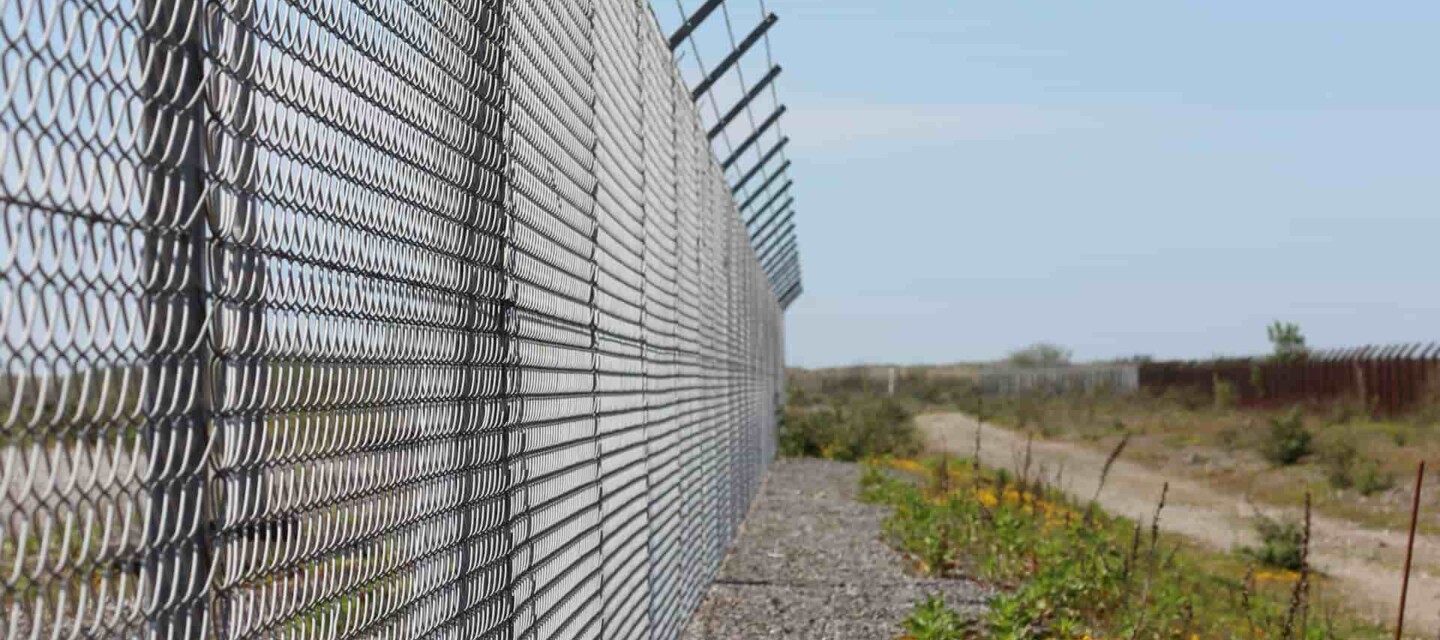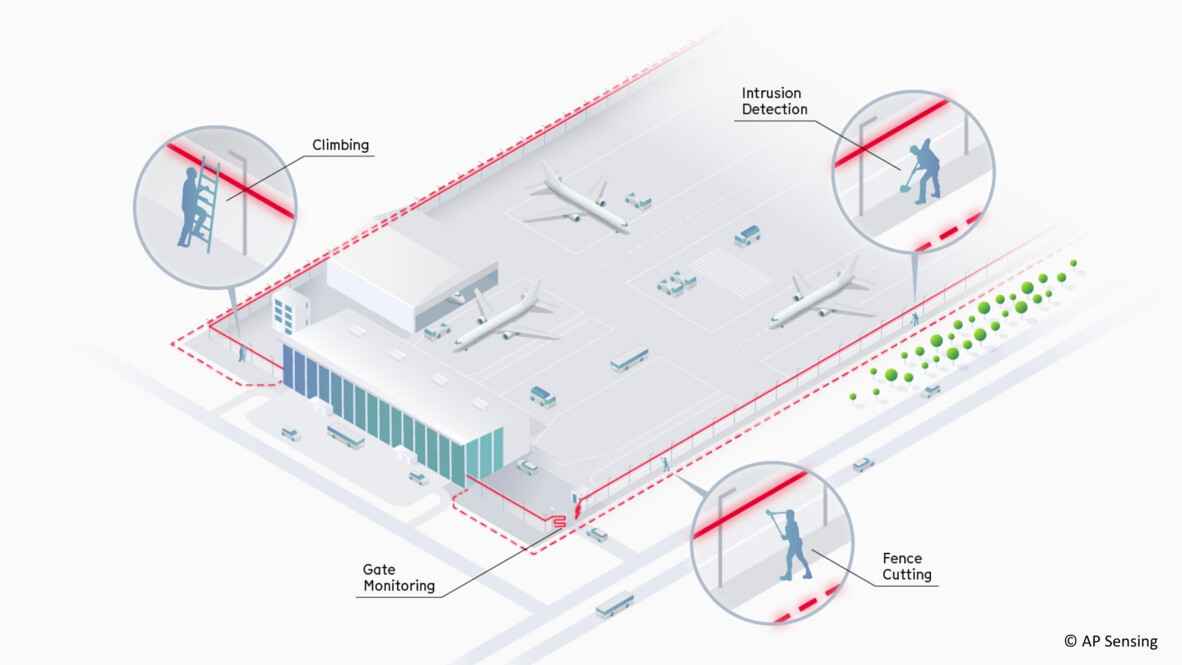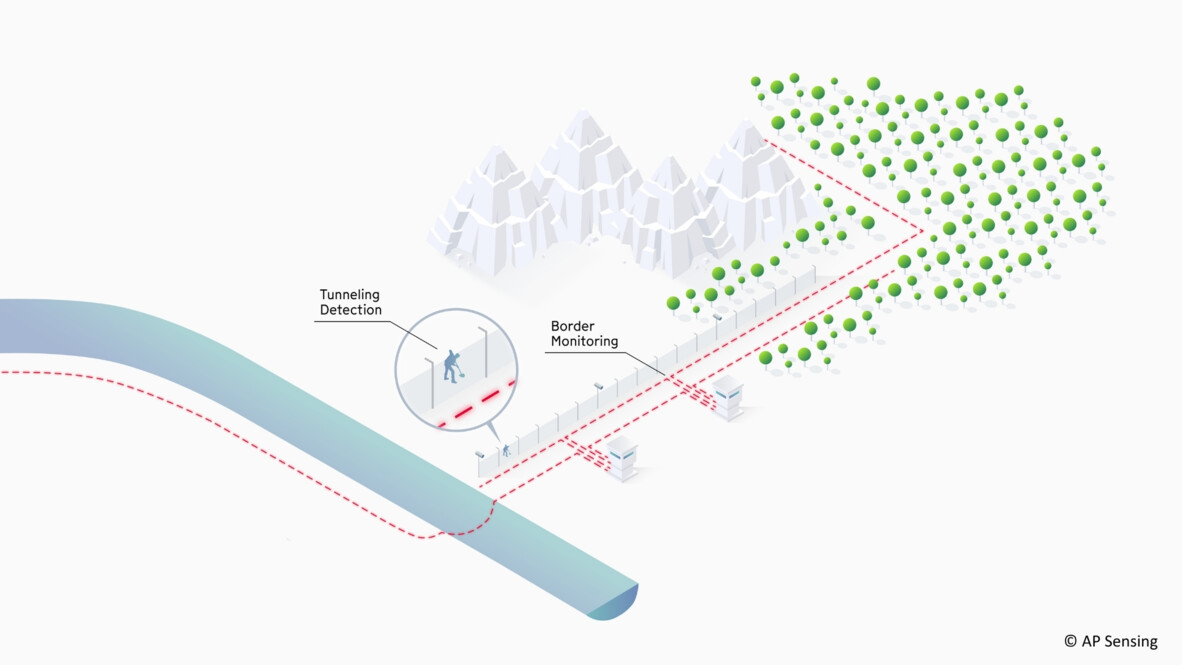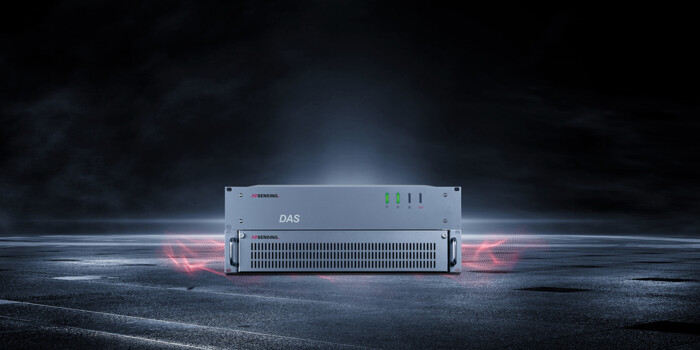Borders, perimeters, and critical facilities define and protect our national sovereignty, public safety, and vital assets - from international borders and airports to energy plants, data centers, production facilities, large scale solar farms and government sites. As the first line of defense, these areas demand continuous vigilance against a growing spectrum of threats.
Today’s perimeter and border operators face an increasingly complex environment. Physical intrusions, sabotage, smuggling, and hybrid threats, such as coordinated attacks and surveillance, are becoming more frequent and sophisticated. Traditional perimeter security technologies that rely on physical fences, cameras, and conventional sensors often struggle with limited range, false alarms, and blind spots, especially across remote or expansive terrains.
Continuous Monitoring of Perimeters & Borders
Distributed Acoustic Sensing (DAS) offers a transformational approach. By utilizing existing or dedicated optical fibers as thousands of virtual microphones, DAS enables real-time detection, classification, and localization of activity along borders and perimeters. Whether it’s people approaching a fence, vehicle movement in restricted zones, or mechanical tampering with physical barriers. DAS delivers quasi real-time, actionable insights before or while intrusions are taking place.
With its ability to cover hundreds of kilometers without the need for in-field electronics, DAS is ideally suited for protecting wide-area infrastructures and remote border regions. It offers unparalleled situational awareness, low false alarm rates, and seamless integration into existing security architectures.
As global security regulations tighten and threats continue to evolve, operators adopt resilient, scalable, and cost-effective technologies like DAS to maintain security, operational continuity, and public trust.
AP Sensing's Monitoring Solution
AP Sensing’s Distributed Acoustic Sensing (DAS) technology delivers real-time perimeter and border protection by transforming standard optical fibers into dense acoustic sensor arrays. Acting as a Perimeter Intrusion Detection System (PIDS), DAS provides continuous, highly precise monitoring. It detects footsteps, vehicle movements, mechanical disturbances, and potential tampering activities along extensive perimeters.
This fiber-based solution ensures comprehensive protection without the need for deploying power or electronics along the monitored line. Installed securely at control centers or protected facilities, the DAS interrogator turns unused or dedicated fibers into thousands of virtual microphones, offering unmatched localization, classification, and alarm capabilities across tens or hundreds of kilometers. Empowering operators to act instantly on detected threats.
Our DAS technology is deployed to protect:
- Transportation hubs, airports, and terminals
- Military facilities and national borders
- Electrical and water utilities
- Pipelines and petrochemical facilities
- Data centers and network infrastructures
- Large power generation stations & solar parks
- Industrial, chemical and production sites
Whether securing a nation's borders, critical utilities, or high-value industrial assets, AP Sensing’s DAS-based PIDS solution provides scalable, proactive and cost-effective protection, ensuring operational resilience, regulatory compliance and public safety.
Event Detection
Event detection using AP Sensing’s fiber optic based Perimeter Intrusion Detection System (PIDS) provides high-resolution, real-time awareness of potential threats to critical perimeters and borders. By transforming optical fibers into thousands of virtual microphones, PIDS ensures continuous acoustic monitoring along the full length of your protected boundary - with precise detection and classification of intrusion activities. Key capabilities include:
Fence-Mounted Intrusion Detection
- Detection of fence climbing and cutting activities, distinguishing between real threats and environmental noise
- Immediate recognition of cable tampering or sabotage attempts
- Reliable rejection of environmental disturbances such as wind, rain, or wildlife — ensuring low false alarm rates
In-Ground Intrusion Detection
- Early detection and localization of digging activities aimed at breaching protected areas
- Identification of human footsteps across monitored zones, even in difficult terrain
- Tracking of vehicle movements along or across perimeters, including off-road driving
- Tamper-proof monitoring: alerts for any attempt to damage, disrupt, or bypass the sensing cable itself
With a DAS-based Perimeter Intrusion Detection System (PIDS), operators move from passive observation to proactive, real-time protection in order to ensure the safety, resilience, and operational continuity of the most critical assets.
Distributed Acoustic Sensing (DAS)
Distributed Acoustic Sensing (DAS) provides continuous, high-resolution monitoring of perimeters and borders by detecting acoustic and vibrational signals that indicate potential threats. Using coherent Rayleigh scattering, DAS transforms standard optical fibers that are installed along fences, buried underground, or integrated into existing infrastructure into dense arrays of virtual microphones. This enables operators to detect and localize activities such as fence climbing, digging, walking, or vehicle movement with exceptional spatial and temporal accuracy. Key benefits are provided by the fiber optic sensor cable, which is completely passive and requires no active electronics in the field. It is maintenance free and survives in most harsh environments.
Enhancing Security with DAS
DAS technology excels at detecting physical impacts, mechanical vibrations, and dynamic movements along extensive perimeter lines. From identifying a climber scaling a fence, to recognizing footsteps across restricted zones or pinpointing vehicle intrusion attempts, DAS delivers real-time situational awareness to protect critical facilities and national borders.
By analyzing the frequency and amplitude of detected signals, DAS enables advanced event classification and thus the differentiation between harmless environmental noise and real threats. The system’s machine learning algorithms further enhance its capabilities, enabling reliable differentiation between digging, walking, or driving activities, while minimizing false alarms caused by wind, rain, or wildlife.
With no need for field-deployed electronics or intrusive infrastructure modifications, DAS offers a scalable, non-invasive, and highly cost-efficient solution for perimeter and border protection that provides operators with actionable intelligence to ensure security, operational continuity, and long-term resilience.

Expanding Our Monitoring Solutions
SmartVision Software for DAS
The platform offers an intuitive graphical interface to monitor live data, review historical events, and track dynamic activities such as fence tampering, digging, or unauthorized movement. DAS event data is mapped directly along the protected perimeter, with color-coded overlays highlighting intrusion activity, signal intensity, and event classifications.
Operators can define virtual zones of interest, such as border crossings, restricted areas, or critical facility access points, and customize alarm thresholds based on specific threat profiles. Integrated AI algorithms automatically classify detected events, enabling immediate action and reducing operator workload. Historical analysis tools further support forensic investigations, trend monitoring, and security performance optimization.
SmartVision integrates easily with existing security, perimeter management, or SCADA systems, providing operators with actionable insights to enhance physical protection, ensure operational resilience, and meet evolving regulatory requirements.
Advantages of AP Sensing's Monitoring Solution
Proactive Protection of Perimeters & Borders
Distributed Acoustic Sensing (DAS) offers a highly effective and scalable method to secure critical perimeters and borders without the need for in-field electronics or extensive infrastructure modifications. By converting existing optical fibers into real-time acoustic sensor arrays, DAS enables continuous surveillance over long distances, even across remote or challenging environments.
AP Sensing’s DAS monitoring solution delivers key benefits by detecting and classifying threats before security breaches occur, preventing costly incidents and reducing the burden on security personnel. It enhances the resilience of physical barriers, supporting the protection of critical assets such as transportation hubs, utilities, data centers, and national borders.
With precise localization and classification of activities like fence climbing, digging, or unauthorized vehicle movement, DAS empowers operators to respond faster, optimize patrols, and reinforce vulnerable areas. This proactive approach results in fewer disruptions, improved threat management, and lower long-term operational costs.
Advantages of DAS for Perimeter & Border Security
- Single-ended monitoring of fences, open terrain, and infrastructure corridors
- Long-range coverage without active field devices
- Accurate classification of intrusion events with low false alarm rates
- Fully passive, tamper-proof, and resilient monitoring architecture
- Ideal for remote, sensitive, or high-security installations
With a proven track record and continued innovation, AP Sensing offers a completely integrated, end-to-end solution made in Germany. Our team works together with you to select the right combination of technologies to fit your requirements. We also provide onsite services, hotline and online support, maintenance and product training.
Find all our brochures, application flyer, product flyers, videos and further case studies in our media library.
Frequently Asked Questions
What does fiber optic based PIDS (DAS) monitor in perimeter and border applications?
DAS detects acoustic signals and vibrations caused by events such as fence climbing, digging, walking, or vehicle movement — alerting operators in real time.
Can DAS monitor both fences and open ground?
Yes. A single DAS interrogator can monitor a sensor cable which is deployed along fence lines, buried underground, and alongside access roads to provide full perimeter and border coverage.
Does DAS require active electronics along the perimeter?
No. DAS is a fully passive technology that operates from a single, centrally located interrogator — no powered field equipment is needed.
How far can a DAS system monitor?
One DAS unit can monitor over 100 kilometers of perimeter with high spatial resolution, making it ideal for both small sites and national borders.
Can DAS differentiate between real threats and environmental noise?
Yes. Advanced signal processing and AI-based classification minimize false alarms by rejecting events caused by wind, rain, or wildlife.



